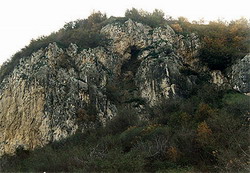|
Jiroft
Lived on Developed Agriculture 5000 Years Ago, Iran Jiroft historical sites which are located next to
Halil Roud River, in the central province of Kerman, are evidence
of a rich ancient civilization once residing there. So far more
than 120 archeological sites including stone tools, crocks, and
architectural remains, have been discovered in a 400-kilometer-long
area which the archeologists have named "the Lost Heaven. Studies have been carried out on more than 500 stone tools recovered there, announced head of the team working on stone tools, Jalal-ed-din Rafi' Far. They prove that the tools were mostly used for agricultural activities, which were quite developed for the time, Rafi' Far told CHN. The tools display the great developed techniques used for their creation, which in turn indicate the civilization's developed agricultural industry. Sediments and remains of plants are still visible on the tools. The scholars working in the area have also found some hunting tools, but the abundance of the agricultural ones have made them believe that people of Jiroft lived mostly on agricultural products. The third season of archeological excavations in Jiroft started one month ago with more than 20 Iranian, French, and American experts taking part. The recent works have moreover led to the discovery of some carved stones throughout the sites. Head of the archeology team of Jiroft, Majidzadeh, told CHN that unearthing the masonry workshops of the area with the help of these carved stones is one of the team’s newest goals. Mazandaran's
site back to 11,000 years ago opens to public
Kumishan is one of the famous caves of Mazandaran which dates back to the palaeolithic era, and the new discoveries indicate that it was then used as a human habitation. Work in the cave started two years ago and included digging boring pits and stratigraphy studies, plus cleaning it up to prepare it for public visits after a 16-year break, archeologist with the Cultural Heritage and Tourism Department of Mazandaran, Ali Mahforouzi, told CHN. Numerous human and animal remains were discovered during the excavations, which were studied during the past months, added Mahforouzi. Some of the bones belong to supersize animals dating to the palaeolithic era or 11000 years ago, and some belong to herbivorous ones such as wild goats. Marjan Mashkour, the animal archeologist in charge of studying the bones, believes that after being hunted, these animals were used as food by the palaeolithic humans. A large amount of tools, including chisels and hunting tools, were also found in the cave. The tools seem to be created during the same time. The excavations moreover led to the discovery of some pottery dating back to the neolithic era, or some 8000 years ago, which indicates that people continued to use the cave as a residence up to then. Mazandaran province, in the southern coastal line of the Caspian Sea, enjoys several unique caves similar to Kumishan which are to be turned into museums to attract tourists. Kumishan Cave will be ready for public visits in two-month time, as said by Mahforouzi.
|
